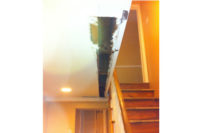Celebrity Restoration: Busted Pipe Leads to Flooded Crawlspace for “Little House on the Prairie” Star






You know the drill by now: There’s a residential loss. The homeowner calls their insurance company to file a claim. The job gets started.
Recently this very situation took place for Melissa Gilbert, who made a name for herself on “Little House on the Prairie” and, more recently, as a contestant on “Dancing With The Stars.” She had a loss at her Los Angeles home when a pipe break in the crawlspace flooded out the area. Melissa called on a local restoration company to complete the job – which they did in about a week. All was well until she went to sell her home and an inspection revealed a large pool of water in the crawlspace. The home sale was halted and Melissa was back to square one – calling her insurance company for assistance.
That’s where O.P. Almaraz and Allied Restoration Services Inc. entered the picture. As it turns out, the crawlspace was never dried out by the previous restoration company. And upon further inspection, mold growth in the crawlspace and water damage to the kitchen’s hardwood floor was also discovered. Allied Restoration had 21 days to complete the necessary work – if they didn’t within the time frame, the real estate transaction risked termination.
A containment chamber was set up in the crawlspace, where the mold was identified and confirmed by a laboratory. The containment was placed under negative pressure in preparation for abatement. Fans were brought back into the home, but this time they were placed in strategic areas to create positive air pressure. This was done to counteract the stack-effect in homes with a crawlspace or multiple levels, and help control mold spores from migrating into the home from the crawlspace. The water in the crawlspace was extracted, however due to the length of saturation time, multiple extractions were needed as water was drawn up from the soil.
With mold abatement complete and clearance achieved, containment was removed and aggressive drying of the soil began. Allied Restoration brought in a 750-cfm desiccant dehumidifier and multiple ETES units to dry the crawlspace. The extra equipment required a spider box installed directly into a 50-amp circuit at the house panel. Limited crawlspace access required that all equipment remain outside the crawlspace, with airflow ducted in. The desiccant airflow and ETES airflow was routed via ducts throughout the crawlspace for dry down. An area of the crawlspace unaffected by the loss was measured to establish a dry standard and set dry down goals. Allied technicians quickly noticed that the soil was not drying out as intended. The remedy was to hand till the soil twice a day, a technique which yielded success.
Meanwhile, upstairs in the kitchen, the custom plank hardwood floor had to be removed and replaced in the 850 square-foot kitchen. The challenge in this floor replacement was not so much the size of the room, but in removing the restaurant grade appliances. The oversized appliances were originally installed in the kitchen, prior to a remodel that removed an archway and replaced it with a standard sized doorway. This meant that the appliances could not be removed from the kitchen without cutting open the doorway to make room.
Allied technicians detached and moved the appliances to one end of the kitchen area to remove the old hardwood floor and partially install the new hardwood floor. Then, they moved the appliances back to their original locations and removed the other side of the kitchen floor to install the rest of the new hardwood. Since Melissa elected to use a pre-finished engineered hardwood floor, the replacement floor was installed in less than four days.
Overall, the project was a success. Melissa’s water loss is typical of everyday jobs restoration companies work on. What made this job unique was all of the complexities and limitations added. Allied Restoration listened to Melissa’s pain and developed a plan that incorporated everything that was important to her. Daily project communication was vital and it kept Melissa informed. Allied Restoration Services Inc. used experience and IICRC training to bring in the right equipment and techniques, which allowed this project to be completed ahead of schedule in 17 days. The sale of the home resumed.
How can you satisfy your customers?
- Be an expert: Know your business and invest in continual education for you and your staff.
- Build rapport with your customer: This is accomplished in many ways, the most important method in this example is to deliver constant communication.
- Find your customers true pain: This is the most important key to a true satisfied customer. Too often, as restorers, we think that the customer’s pain is the fire damage or water loss they are experiencing. It’s not. If you build enough rapport, you can uncover the real pain that lies beneath the surface. The truth is that if you are not adding more value into your customer’s life, you will not sustain long-term success.
Looking for a reprint of this article?
From high-res PDFs to custom plaques, order your copy today!











